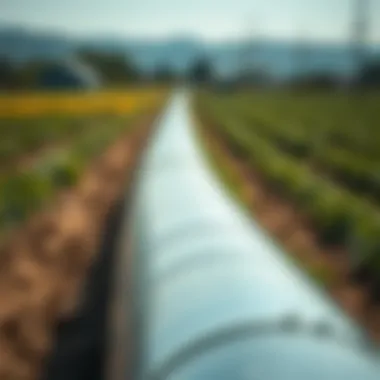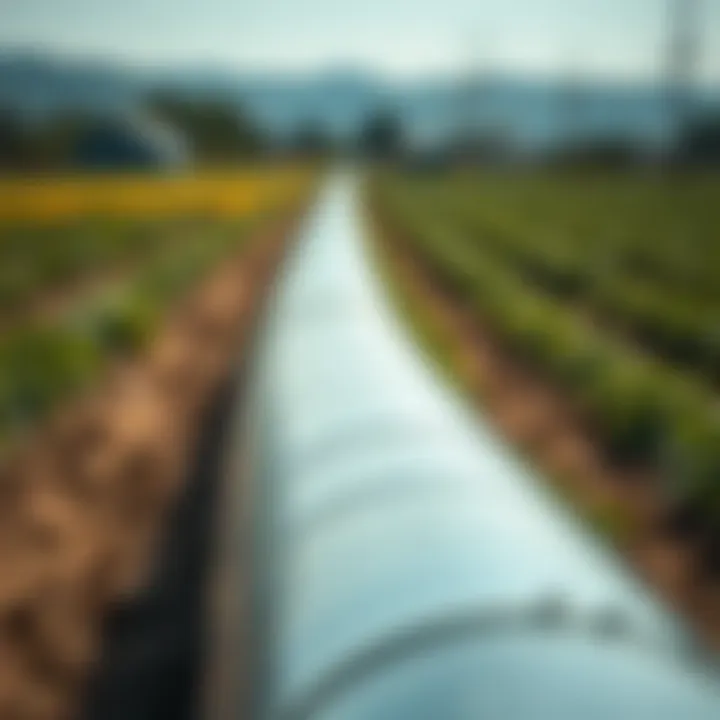The Impact of CO2 Generators on Agricultural Practices


Prelims
The landscape of agriculture is rapidly changing, shifting towards methods that harness technology while keeping sustainability at the forefront. One significant advancement fueling this transformation is the use of CO2 generators. As farmers and agricultural enthusiasts explore innovative ways to enhance crop production, understanding the role of carbon dioxide becomes paramount. This article aims to illuminate how CO2 generators function, their benefits in promoting growth, and their essential place in contemporary farming practices. The narrative will take you through their operational intricacies, environmental considerations, and community best practices that align with sustainable agriculture ideals.
Latest Trends in Agriculture
Overview of Current Trends
In the modern agricultural scene, the integration of technology is not merely an advantage; it has become a necessity. Farmers increasingly rely on data-driven techniques, automation, and controlled environment agriculture. This trend enhances efficiency and optimizes resources. CO2 generators fit snugly into this scenario, serving as pivotal tools for cultivating high-yield crops. Their contribution stems from an acute understanding of plant biology, where elevated CO2 levels correlate with enhanced photosynthesis and improved plant vigor.
Impact of Technology on Farming Practices
The advent of smart farming practices has transformed the sector. With tools such as sensors, drones, and automation software, farmers are equipped to monitor crop health, soil conditions, and environmental factors with striking precision. The data collected allows for tailored adjustments in plant nutrition and CO2 levels. As farmers embrace these technologies, their ability to manage resources effectively can lead to greater sustainability and improved profitability. CO2 generators serve as a cog in this intricate machine, ensuring that the carbon dioxide levels are conducive for robust plant growth.
Sustainable Practices: Towards a Greener Future
Importance of Sustainability in Agriculture
As the population burgeons, the agriculture industry faces increasing scrutiny. Sustainability is no longer just a buzzword; it is a requisite guiding principles for agricultural practices. Embracing sustainable practices ensures that natural resources are preserved for future generations. CO2 generators contribute to these efforts by optimizing growth in a more environmentally responsible manner, allowing farmers to achieve impressive yields while minimizing resource wastage.
Methods for Sustainable Farming
To adopt a sustainable approach, farmers can consider the following methods:
- Implementing precision agriculture technologies to reduce resource input
- Utilizing organic fertilizers to enhance soil health
- Adopting crop rotation and cover cropping to improve biodiversity
- Integrating CO2 generators to control and customize growth environments, thus minimizing resource waste
Sustainable farming is not just about preserving what exists but also facilitating growth for a better tomorrow.
Gardening Techniques and Tips
Essential Gardening Tools and Equipment
For those looking to get their hands dirty and engage in small-scale farming or gardening, having the right tools is crucial. Some key tools include:
- Pruning shears for plant maintenance
- Soil testers to gauge nutrient levels
- Watering systems that conserve water
- CO2 enrichment kits for optimizing plant growth
Seasonal Gardening Practices
Gardening requires adaptation to seasonal changes. This can range from understanding when to plant specific crops to adjusting CO2 levels as environments change. Seasonal practices also involve nurturing plants by adapting watering schedules and nutrients based on climate conditions. For instance, maintaining higher CO2 concentrations can support early plant growth in controlled environments like greenhouses, ensuring robust productivity year-round.
Throughout this article, the interplay of CO2 generators and modern agricultural practices will emerge as a central narrative. Harnessing technology while prioritizing sustainability illuminates the pathway for agricultural professionals and enthusiasts alike. Fully grasping the practical applications and benefits of these generators can be the difference between mediocre and bountiful harvests.
Prolusion to CO2 Generators
In the world of agriculture, especially in modern practices, CO2 generators have become quite the unsung heroes. They play a pivotal role in enhancing plant growth and boosting yield through the careful manipulation of Carbon Dioxide (CO2) levels in various farming environments. As the quest for higher efficiency and healthier crops intensifies, understanding the functionality and importance of these devices cannot be overemphasized.
Definition and Purpose
A CO2 generator is, in essence, a machine designed to emit carbon dioxide into the environment. This might sound simple, but its implications stretch far and wide. The primary purpose of these generators is to supplement CO2 levels in greenhouses or indoor farms where natural concentrations may fall short. The relationship between increased CO2 and plant photosynthesis is significant; it’s like giving plants a turbo boost. By optimizing the concentration of CO2, farmers can witness enhancements in growth rates and even the quality of their produce.
The generators can be powered by various fuels, each offering distinct pros and cons. For example, LPG-powered generators are widely used for their effectiveness and relatively lower cost, whereas electric CO2 generators provide a cleaner alternative with less environmental impact. Understanding these options allows farmers to tailor their approach based on specific needs and circumstances.
Historical Context
To appreciate the role of CO2 generators today, it's utile to look back at the timeline of agricultural advancement. Historically, farmers relied on natural resources and elements to support plant growth; however, as society progressed into modernity and embraced technology, innovations like CO2 generators started bubbling up. The production of controlled environments began in the mid-20th century, aligning with advancements in greenhouse technology. Initially, CO2 was injected manually or generated through combustion processes in heating systems.
Over the decades, as knowledge of plant physiology and gases improved, these systems evolved. The introduction of more sophisticated CO2 generation techniques saw agriculturalists begin to embrace the idea of manipulating greenhouse climates to achieve optimal growth conditions.
Today, these devices are integral for both small-scale urban farms and expansive commercial agriculture. Farmers and enthusiasts alike are capitalizing on the science of CO2 enrichment to push boundaries in gardening, contributing significantly to food production and sustainability.
The evolution of CO2 generators encapsulates the broader shift in agriculture towards not just meeting demands but exceeding them, echoing the ethos of innovation and sustainability in farming practices today.
Mechanics of CO2 Generation
Understanding the mechanics of CO2 generation is crucial for modern agricultural practices. This section delves into the details of how CO2 is produced and the different technologies that facilitate this process. By grasping the underlying chemical processes and various types of generators, farmers can better appreciate how CO2 enrichment can lead to improved plant health and yields. This knowledge empowers them to make informed decisions when selecting CO2 generators for their specific agricultural needs.
Chemical Processes Involved
The generation of CO2 typically hinges on a few significant chemical processes, which are fundamental in understanding how CO2 is utilized in agriculture. The most common method involves combustion reactions, where fuels like propane or natural gas react with oxygen to produce CO2 and water vapor as byproducts.
In more controlled environments, CO2 can also be generated through chemical reactions that do not rely solely on combustion. For instance, certain acids can release CO2 when they interact with carbonates.
In both scenarios, it's vital to monitor the concentration of CO2 produced. Elevated levels can enhance photosynthesis, subsequently increasing growth rates in crops. However, an improper balance can result in detrimental effects on plant and human health, hence the importance of precision in these processes.
Types of CO2 Generators
When exploring CO2 generators, it's essential to note that various types exist, each tailored to different needs and environments within agriculture. Below are the primary types:


LPG-Powered Generators
LPG (liquefied petroleum gas) powered generators are quite common in agricultural settings. Their main advantage lies in their efficiency and ease of use. Farmers favor LPG for several reasons:
- Cost-Effectiveness: LPG tends to be cheaper than many alternatives, especially in regions where natural gas is not readily available.
- Portability: These generators can be moved easily, making them versatile for different locations.
A unique feature of LPG-powered generators is their ability to produce a large amount of CO2 in a short duration. However, they do produce emissions that can impact air quality, necessitating careful management.
Natural Gas Generators
Natural gas generators are another integral type of CO2 generator. They are known for their cleaner combustion compared to LPG. Here are some key points:
- Environmentally Friendly: With lower greenhouse gas emissions, natural gas is often regarded as a more sustainable choice. This aligns with global efforts toward environmentally-conscious farming practices.
- Efficiency: These units have a high energy output and are suitable for larger-scale operations.
Nevertheless, the initial investment in natural gas infrastructure may be higher. Farmers must weigh long-term savings against upfront costs when choosing this generator type.
Electric CO2 Generators
Electric CO2 generators are gaining traction, especially in urban farming and greenhouse setups. They offer unique benefits:
- Reliability: Operating on electricity, these generators require less maintenance and deliver consistent performance.
- Precision Control: Many electric units come equipped with technology to monitor CO2 levels accurately.
However, the reliance on electricity can pose challenges, particularly in areas with unstable power supplies. Additionally, the cost of electricity compared to gas varies widely by region, influencing the long-term feasibility of electric generators.
In summary, the mechanics of CO2 generation encompass various chemical processes and types of generators, each contributing uniquely to agricultural practices. By comprehending these elements, farmers can optimize their crop production strategies, ensuring both yield and sustainability.
Impact of CO2 on Plant Growth
Understanding the role of carbon dioxide in agriculture isn't just an academic exercise; it's a cornerstone for driving modern farming practices. CO2 functions as a crucial ingredient in photosynthesis, which is the lifeblood of plant growth and development. This section unravels the implications of enhanced carbon dioxide levels on plant growth, focusing on how these processes cement the foundation for fruitful yields and sustainable agriculture.
Photosynthesis and CO2
To grasp how CO2 impacts plant growth, one must look no further than the process of photosynthesis. Plants take in carbon dioxide from the atmosphere, combine it with water, and under the influence of sunlight, convert it into glucose and oxygen. It's a chemical magic trick that powers nearly all life on Earth. When CO2 levels are elevated, studies have shown plants can photosynthesize more efficiently, leading to enhanced growth.
The relationship between CO2 and photosynthesis is a robust one. For instance, in environments where CO2 concentrations increase, such as greenhouses engineered for optimal growth, the plants often exhibit accelerated growth rates and increased biomass. This direct correlation can be compelling: higher carbon concentrations often result in more vigorous photosynthesis, a critical driver of healthy plants.
Growth Metrics
Yield Increases
When we talk about yield increases, it's not just about numbers; it’s about changing the game for farmers. Elevated CO2 levels allow crops to grow larger and faster. For instance, research indicates that some staple crops like wheat and rice can yield up to 20% more under high CO2 conditions. This boost in production is crucial as it underscores the ability of farmers to meet the growing food demands of a burgeoning global population.
Why is this phenomenon appealing? It's simple: greater yields translate to increased profitability and efficiency. Additionally, higher yield per acre means less land needs to be converted into farmland, preserving natural habitats. However, achieving these results isn't a cakewalk; it necessitates careful management of other environmental factors such as water and nutrients.
Quality of Produce
Quality of produce encompasses not only the aesthetic aspect — think color and size — but also nutritional content. Increased CO2 levels can indeed lead to better quality fruits and vegetables. For instance, tomatoes grown in CO2-rich environments tend to develop richer flavors and superior coloration.
Nonetheless, it's a double-edged sword. Research suggests that while certain crops may benefit from enhanced CO2, others might experience reduced nutritional quality, especially in terms of vital minerals like calcium or magnesium. This is a significant consideration for farmers who are not only striving for quantity but also for the health of their consumers. The unique feature of quality is that it encompasses both taste and nutrition; it's not just what looks good, it’s about delivering healthier options to the marketplace.
Crop producers need to be savvy about their practices, balancing the quest for higher yields with the necessity of quality. In practical terms, this could mean something as straightforward as incorporating nutrient-dense fertilizers alongside CO2 enhancements, thereby ensuring a holistic approach to production that checks both boxes of yield and quality.
"The intricate dance between CO2 levels and crop outcomes isn’t just a scientific curiosity; it’s a critical lens through which modern agriculture must be viewed."
This exploration into the impact of CO2 on plant growth reveals its essential contributions while also highlighting the challenges and potential pitfalls farmers face in today's complex agricultural landscape.
Applications in Agriculture
The use of CO2 generators in agriculture isn't just a fad; it is, rather, a practice grounded in the legitimate need for enhanced crop production and sustainability. The diverse applications of CO2 generators play a crucial role in optimizing growth conditions for plants, ensuring that farmers are equipped to overcome some of the greater challenges presented by climate change and increasing global populations. Whether operating inside controlled environments or out in the fields, the value of CO2 supplementation cannot be overstated.
Greenhouses
Greenhouses represent the epitome of controlled agricultural environments. By harnessing natural sunlight while shielding plants from unpredictable weather conditions, they create an ideal setting for cultivation. Here, CO2 generators find an efficient application. Maintaining optimal levels of carbon dioxide can significantly enhance photosynthesis, leading to accelerated plant growth and larger yields.
Farmers operating greenhouses often face limitations on land size. Thus, maximizing production per square foot becomes paramount. Adding CO2 helps propel this effort. In well-ventilated greenhouses, where plants often experience fluctuating CO2 levels, a generator can ensure that concentrations reach about 1,000 to 1,200 parts per million—a level significantly above ambient outdoor conditions that can promote robust plant development.
"The difference in yields between a greenhouse using CO2 generators and one that doesn't can often be quite staggering—it's not merely an enhancement, it can be a game-changer for greenhouse operations."
Indoor Farming
Indoor farming is a burgeoning field, leveraging artificial lighting and controlled atmospheres to cultivate crops year-round, independent of external environmental fluctuations. In such environments, effective CO2 management is crucial for achieving optimal growth conditions. Here, CO2 generators serve as a reliable source, enabling farmers to optimize photosynthetic efficiency and achieve year-round production.
With indoor systems, growers can utilize technology to measure and adjust ambient conditions finely. Many indoor farms find that the combination of advanced lighting and CO2 enrichment leads to impressive harvests. As indoor farming continues to rise in popularity, the strategic use of CO2 generators is expected to play a central role in maximizing efficacy and fostering the sustainability of these operations.
Traditional Field Cultivation
While greenhouses and indoor systems benefit tremendously from regulated CO2 levels, traditional field cultivation is also evolving to adopt newer practices. Though many outdoor farms might overlook CO2 generators, their potential applications cannot be dismissed. By strategically employing CO2 supplementation, farmers can navigate challenges posed by less-controlled environments and competitive growth.


One common strategy is to introduce CO2 generators during critical growth stages, such as flowering. This targeted approach can enhance yields without excessive investment in continuous CO2 production. Making use of CO2 during specific phases can lead to noticeable differences in crop health and assembly. It’s worth noting that, in the context of traditional farming, blocking out the competition from weeds and pests, along with adequate CO2 levels, can pave the way for robust produce.
As agriculture strides forward, embracing technologies like CO2 generators will be vital not only for boosting productivity but also for aligning with the sustainability goals that have become increasingly pronounced in agricultural discussions.
In summary, the applications of CO2 generators across different agricultural practices underscore their significance in a world constantly adapting to new challenges. By understanding and leveraging these practices, farmers can position themselves for greater success and sustainability.
Benefits of Using CO2 Generators
In the realm of modern agriculture, the use of CO2 generators has garnered attention not merely as a trend, but as a significant evolution towards optimizing crop production. The importance of understanding the benefits of these generators cannot be overstated. They present a multifaceted approach to addressing some of the critical challenges that farmers face today, from inconsistent yields to the health of their plants. By leveraging CO2 generators, agricultural operations can enhance productivity, improve the overall health of crops, and achieve cost efficiencies.
Enhanced Crop Yields
One of the foremost advantages of implementing CO2 generators is the noteworthy increase in crop yields. When plants are exposed to elevated levels of carbon dioxide, they tend to photosynthesize more effectively. This leads to greater biomass production, which ultimately results in more plentiful harvests. For instance, studies have shown that increasing CO2 levels can boost yields of common crops like tomatoes and lettuce by as much as 20-30% under controlled environments, such as greenhouses.
Moreover, CO2 is a crucial element in the growth process; it acts as a raw material for photosynthesis, the very mechanism through which plants convert light into energy. By systematically elevating CO2 concentrations during key growth phases, farmers can harness natural biological responses to their advantage.
Improved Plant Health
Aside from mere yield increases, CO2 generators also promote enhanced plant health. Healthy plants are more resilient, and greater CO2 levels often correlate with stronger root systems and less susceptibility to disease. This leads to a more robust crop overall, capable of withstanding the unpredictable whims of nature.
Furthermore, plants grown with optimal CO2 levels tend to exhibit better nutrient uptake. This enhancement can translate to improved quality of produce, with certain varieties showing better color, flavor, and nutritional value. For instance, studies on peppers indicate that enhanced CO2 can lead to increased vitamin C content. Greater plant health also reduces the need for chemical remedies, promoting a more organic farming approach.
Cost Efficiency
Implementing CO2 generators can also yield significant cost savings in the long run. While there is an initial investment involved, many farmers find that the return on investment justifies the expense. Higher yields and healthier plants often result in increased profitability and sustainability over time.
Additionally, by improving the overall efficiency of plant growth, farmers can save on other inputs, such as fertilizers and pesticides. This reduction in resource spending aligns with modern agricultural practices focused on sustainability and environmental stewardship.
CO2 generators can also be utilized effectively in conjunction with various other technologies in the farm ecosystem. For instance, integrating automated systems for CO2 monitoring can enhance overall efficiency and optimize operations, ensuring that crops receive exactly what they need without excess.
"Investing in CO2 generators is not just about boosting crop yield. It's about revolutionizing the way we think about plant health and resource use in agriculture."
Challenges of CO2 Generators
While CO2 generators play a significant role in enhancing agricultural productivity, they also come with a set of challenges that need to be navigated carefully. These challenges encompass safety concerns, investment costs, and environmental considerations. Addressing these challenges is crucial for any farming operation that aims to implement CO2 technologies effectively.
Safety Concerns
Safety is paramount when utilizing CO2 generators. As these devices emit carbon dioxide, there's a real risk of creating an environment where CO2 levels can become dangerously high, especially in enclosed spaces such as greenhouses. Without proper ventilation, workers and plants can suffer from CO2 toxicity. Therefore, it's essential to maintain accurate and timely monitoring of CO2 concentrations. Installing CO2 detectors adds another layer of safety, alerting users when levels rise beyond safe thresholds. Training personnel on emergency procedures is critical; even a well-functioning CO2 generator can malfunction or create unexpected hazards.
Additionally, the combustion processes involved in certain types of generators, like propane-based models, can produce harmful byproducts. Ensuring that equipment is regularly serviced is a must.
Investment Costs
Investing in CO2 generators can be a significant financial commitment for agricultural enterprises. The initial costs associated with purchasing, installing, and maintaining these systems can create a barrier to entry for smaller farms. For instance, high-quality electric generators, while they tend to have lower operational costs in the long run, often come with a steep price tag up front.
However, it’s important to analyze the return on investment. Higher yields and improved crop quality could well offset the initial expenses, but this is not always guaranteed. It is wise for farmers to conduct thorough cost-benefit analyses not only before purchasing but also when considering upgrades or expansions of their CO2 systems.
In practice, some might find it beneficial to explore alternative funding avenues. Grants or subsidies aimed at promoting technological advancements in agriculture could alleviate some financial burdens.
Environmental Considerations
The environmental impact of CO2 generators cannot be overlooked. While the goal is to increase the available carbon dioxide for plant uptake, the source of the CO2 production is a fundamental concern. Fossil-fuel-based generators can lead to greenhouse gas emissions, which counteracts the positive aspects of enhanced crop growth.
There’s also the issue of energy consumption. The more efficient the generator, the better it will be for the environment and overall sustainability. Following a trend toward sustainability, many farms are shifting towards electric or biofuel generators, which are often seen as more eco-friendly alternatives.
Finding a balance between effective crop production and environmental stewardship is key. Farmers must weigh their operational methods and choose generators that align with both their production goals and sustainability commitments.
In essence, while CO2 generators offer crucial benefits for plant growth, the safety, financial, and environmental challenges they bring to the table are vital to acknowledge. Implementing best practices in handling these issues will ensure a balanced approach to modern agriculture.
For further reading on safety protocols, investment strategies, and environmental best practices, please check out resources on osha.gov and usda.gov.
Ultimately, the prudent management of these challenges will elevate the efficacy of CO2 generators and lead to a more prosperous agricultural landscape.
Best Practices for Implementation
Implementing CO2 generators effectively in agriculture requires a considered approach. The benefits of optimal use extend far beyond just enhancing plant growth. Understanding and applying best practices can greatly improve efficiency and sustainability. Below, we explore several essential aspects that farmers and agricultural enthusiasts should pay attention to when it comes to integrating CO2 generators.
Monitoring CO2 Levels
Monitoring your CO2 levels is akin to checking the pulse of your plants. An accurate and consistent assessment is critical.
- Why Monitoring Matters: CO2 concentration directly influences photosynthesis rates and consequently overall crop yield. Maintaining levels around 1,000 to 1,500 ppm is ideal for most plants. Too little CO2 can stunt growth, while excessive levels can lead to adverse effects on plant health.
- How to Monitor: Use digital CO2 sensors placed strategically throughout the growing area. Tools like the Airthings Wave Plus or the SensorPush are great choices for continuous monitoring. Regular calibration of these devices ensures accuracy.
To maintain optimal growth, adjust your CO2 generator based on real-time data. Regularly monitoring helps avoid oscillations in CO2 concentration, which can confuse plants and inhibit growth.
Integrating with Other Technologies


Incorporating CO2 generators alongside other agricultural technologies can create a synergistic effect, leading to better overall efficiency.
- Climate Control Systems: By integrating CO2 generators with HVAC systems or fans, you can enhance airflow while distributing CO2 evenly across your grow space. This improves growth consistency by preventing localized excesses or deficiencies.
- Hydroponic Systems: If you’re using hydroponic farming, the addition of CO2 can further accelerate growth rates. Pair these systems with nutrient management software to optimize both nutrient and gas availability concurrently.
- Smart Agriculture Technologies: Modern IoT (Internet of Things) devices can link CO2 levels with data from light sensors, soil moisture meters, and temperature monitors. By automating adjustments in real time, you can maintain ideal conditions with minimal manual intervention.
Integrating CO2 management with technological advancements makes it easier to fine-tune your grow environment, ensuring your plants receive everything they need to prosper.
Timing and Duration of Use
Optimal timing for CO2 generator use can significantly impact plant development. Just as timing in a recipe is crucial, so is timing for your crops.
- When to Release CO2: Many plants benefit from increased CO2 during the daylight hours when photosynthesis peaks. Starting CO2 injection in the early morning hours allows plants to immediately take advantage of the gas's presence.
- Duration Considerations: A common method is to run generators for 15-20 minutes every couple of hours. However, depending on your grow environment and crop type, you might find different intervals work best. Conducting regular assessments can help pinpoint the sweet spot.
- Seasonal Adjustments: As seasons change, so do plant requirements. In summer, your plants may draw more CO2 compared to winter. Adjust the CO2 levels accordingly; some plants even benefit from cycles of enrichment followed by periods of normal ambient CO2 levels.
Following these practices not only promotes robust growth but also encourages a harmonious relationship between your crops and their environment. Running CO2 generators in alignment with your plants’ natural rhythms can yield fantastic results, thereby encouraging a bounteous harvest.
Case Studies
Case studies offer a window into the real-world applications of CO2 generators, illustrating their transformative effects on agricultural practices. By examining these specific instances, readers can glean insights that go beyond theoretical understanding. Effective case studies not only highlight the mechanics of CO2 generation but also showcase the tangible benefits, challenges faced, and lessons learned in various farming settings. They serve as a source of inspiration for both commercial farmers and urban agriculture enthusiasts, revealing how innovation can drive efficiencies and sustainability in crop production.
Successful Implementation in Commercial Farms
In the realm of commercial agriculture, success is often benchmarked by profitability and efficiency. A pivotal case study that stands out is the use of CO2 generators in a large-scale tomato farming operation in California. By deploying a system that integrates both LPG-powered generators and natural gas generators, the farm observed a significant boost in yield—up to 20% over standard practices. This was attributed to the enhanced levels of CO2 during crucial growth stages.
The farm's management implemented a strict monitoring strategy, utilizing CO2 sensors linked to automation systems that adjusted the output of the generators based on real-time data. This precise control not only maximized growth but also regulated energy consumption, leading to lower operational costs. Moreover, the farm reported that the increased CO2 levels improved the overall quality of the produce, which ultimately resulted in higher market prices.
Key takeaways from this case include:
- Enhanced Yield: A 20% improvement in tomato production.
- Cost-Effective Monitoring: Automated systems reduced human error and energy waste.
- Quality Improvement: The produce fetched higher prices in markets due to better nutritional profiles and flavor.
Innovations in Urban Agriculture
Urban agriculture is an arena where CO2 generators can shine, especially as cities strive to increase local food production amidst rising populations. A highlight can be seen in a rooftop garden project in New York City that utilized electric CO2 generators. This project was designed to maximize space while providing fresh produce to the local community. The integration of advanced LED grow lights alongside CO2 enrichment created an environment conducive to year-round farming, defying the seasonal limitations traditionally faced.
Through innovative design, the team was able to create a closed-loop system that not only produced organic herbs and vegetables but also educated community members about sustainable practices. The use of CO2 generators in this urban setting allowed for controlled growth conditions, promoting larger crop sizes and shorter harvest cycles.
Some notable points from this initiative include:
- Space Efficiency: Utilizing rooftop spaces in dense urban environments.
- Community Engagement: Involvement of local residents in farming practices and education on sustainability.
- Yield Optimisation: Shorter harvest times due to optimized growing environments enhance the productivity of limited spaces.
These case studies shine a light on how thoughtfully designed CO2 systems impact both commercial farms and urban agriculture initiatives, allowing for broader lessons that can be applied in various farming operations.
Future of CO2 Generation in Agriculture
The future of CO2 generators in agriculture is not just a passing trend but a pivotal element that could reshape how we approach farming in the years to come. As climate concerns looms larger and food production faces greater scrutiny, the role of CO2 in optimizing crop yields becomes increasingly vital. Understanding and incorporating advanced CO2 generation technologies can lead to remarkable benefits for farmers, from increased efficiency to enhanced crop quality. Additionally, recognizing the sustainability implications of these practices is crucial for long-term viability in agriculture.
Technological Advancements
As we dive into the technological advancements related to CO2 generation, the landscape is changing rapidly. More innovative CO2 generators are emerging, each designed to be more energy-efficient and environmentally friendly. These advancements include:
- Smart Sensors and Automation: With the rise of Internet of Things (IoT) technology, CO2 generators are now equipped with smart sensors that monitor CO2 levels in real time, adjusting outputs to optimize plant growth. This reduces waste and ensures that plants receive the precise amount they need.
- Renewable Energy Sources: Innovations in renewable energy are also influencing CO2 generation. Using solar panels or wind energy to power generators is becoming feasible, thus decreasing reliance on fossil fuels and mitigating carbon emissions.
- Emission Capture Systems: Some advanced generators now integrate emission capture technologies, meaning that instead of releasing excess CO2 into the atmosphere, they recycle it. This circular approach allows for sustainable farming practices that minimize environmental impact while maintaining productivity.
"The integration of technology in CO2 generation is not only about increasing yield but also about preserving the planet for future generations."
These advancements pave the way for a more sustainable agricultural framework, ensuring that farmers can produce food efficiently without pushing the boundaries of environmental safety.
Sustainable Practices
Sustainability is a cornerstone of modern agriculture, and when it comes to CO2 generation, it's all about balancing productivity with environmental responsibility. Implementing sustainable practices in CO2 generation can significantly reduce ecological footprints while enhancing crop productivity. Some sustainable practices include:
- Integrated Pest Management: Employing CO2 generators can indirectly benefit pest control strategies. By optimizing growth conditions, healthier crops can better withstand pest pressures, reducing the need for chemical pesticides.
- Crop Rotation and Diversity: Coupled with appropriate CO2 generation, rotating crops and promoting biodiversity can help improve soil health and resilience. This enhances the efficacy of CO2 in driving photosynthesis, ultimately leading to better yields.
- Water Management: With the right level of CO2, crops require less water. By strategically managing water while optimizing CO2 levels, farmers can conserve this precious resource, particularly in regions suffering from drought.
The future of CO2 generation in agriculture holds the promise of not just feeding the growing population, but doing so in a manner that respects and nurtures the environment. Through embracing both technological advancements and sustainable practices, farmers have a unique opportunity to navigate the complex landscape of modern agriculture successfully, ensuring food security without compromising ecological integrity.
For more insights into sustainable agriculture practices, you can explore resources from USDA and FAO to learn more about innovative farming techniques.
End
The role of CO2 generators in modern agriculture cannot be overstated. These devices serve as a vital tool for enhancing the cultivation of crops across various environments, from sprawling greenhouses to compact urban farms. As the agricultural landscape faces the challenges of climate change and an ever-growing global population, the integration of CO2 generators holds the promise of not just sustaining but significantly boosting food production.
Summary of Key Insights
The insights gathered throughout this article highlight several crucial points:
- Mechanism of Action: CO2 generators work by increasing the carbon dioxide levels in the air, an essential gas for photosynthesis, thus leading to enhanced plant vitality and growth.
- Applicability: The application extends beyond greenhouses to include indoor farming and traditional field cultivation, each benefitting from tailored CO2 management strategies.
- Benefits: Key advantages derived from using CO2 generators include improved crop yields, enhanced produce quality, and better overall plant health.
- Challenges: Addressing safety concerns, understanding investment costs, and contemplating environmental ramifications are essential for adopting this technology responsibly.
- Best Practices: Proper monitoring and integration of CO2 generators with other agricultural technologies can optimize their efficacy, ensuring maximum benefits while minimizing risks.
- Future Outlook: The technological advancements in CO2 generation promise not only to improve the efficiency of these systems but also to make them more sustainable, further aligning with global efforts toward environmental stewardship in agriculture.
Final Thoughts on CO2 Generators in Modern Farming
As we move forward, the engagement with CO2 generators symbolizes more than just enhancing yields—it's a step towards innovative farming practices that can keep pace with the mounting pressures of food security. The dialogue surrounding CO2 in agriculture must include discussions about sustainability, cost-effectiveness, and safety to ensure its responsible implementation.
In closing, as agricultural farmers and enthusiasts navigate through complex challenges, they find in CO2 generators not merely a tool, but a component of a holistic approach to modern farming—one that is equipped to adapt to the dynamics of our changing world. By harnessing these generators wisely, the agricultural community can strive toward resilience, efficiency, and sustainability.
"Innovation in farming is not just an option anymore; it’s a necessity for survival in the 21st century."
For more detailed insights on CO2 generators and their implications in agriculture, consider visiting Britannica, Wikipedia, and engaging in discussions on platforms like Reddit and Facebook.







